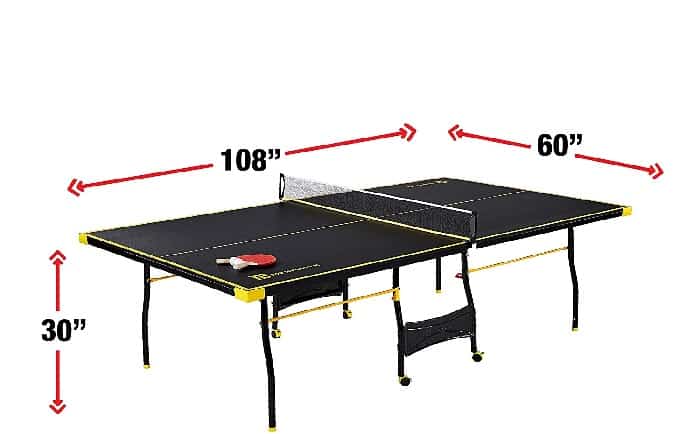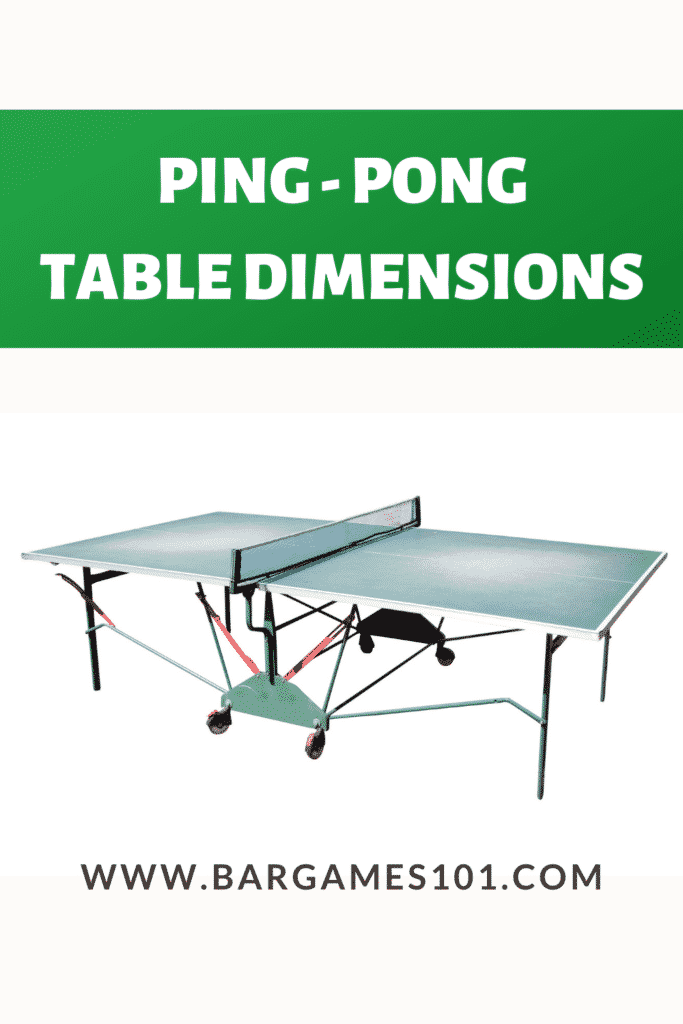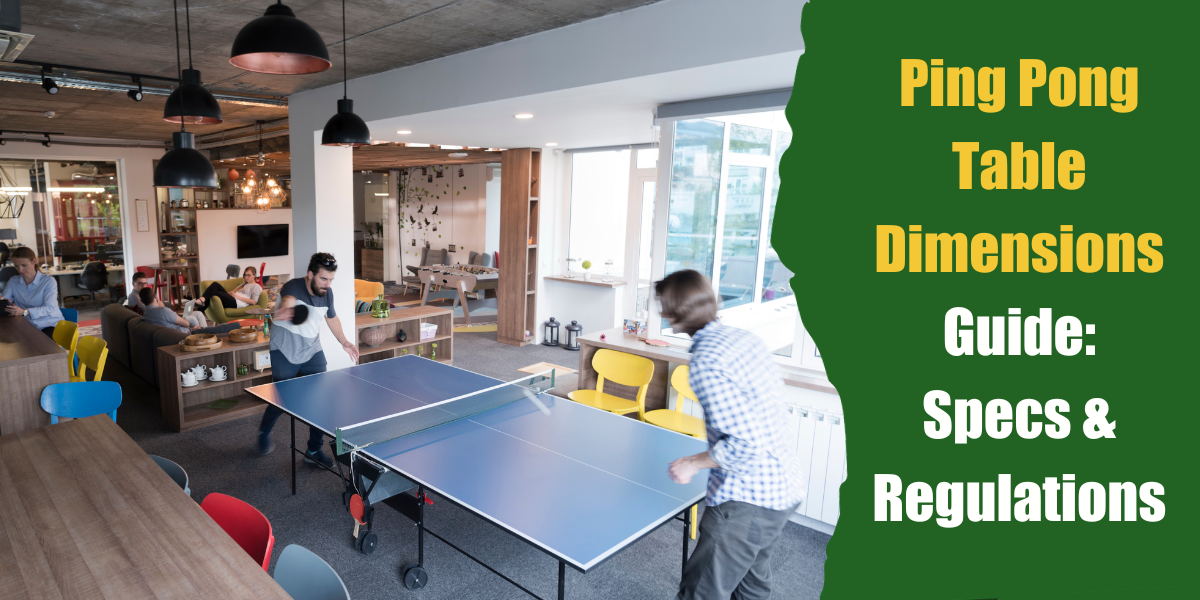If you’re shopping around for a new addition to your game room, you’ve likely noticed that ping pong table dimensions can vary greatly from brand to brand.
On the face of it, this isn’t such a terrible thing. In fact, it actually improves your chances of finding a table that best suits both your space and the kind of game you want to enjoy.
After all, there’s a big difference between a regulation-size ping pong table used for competitive play and a beginner-friendly table suitable for introducing your kids to this fun, fast-paced sport.
Still, all those different sizes do mean that it pays to do a little planning to ensure you buy a table that not only fits into your space, to begin with, but that also gives you plenty of room to maneuver once the game gets underway.
With that in mind, we’ve gone through everything you could possibly need to know about ping pong table dimensions and brought it all together into this one helpful, fully-comprehensive guide.
Regulation Ping Pong Table Dimensions Guide

Like the majority of sports, ping pong (or table tennis as it’s also known) has its own official governing body responsible for overseeing all aspects of the game. In this case, that responsibility falls to the International Table Tennis Federation (ITTF), a regulatory body that is based in Germany, Switzerland, and Singapore, but which determines the rules and standards for competitive table tennis throughout the world.
The ITTF doesn’t just determine how the game is played and how points are scored, they also set the rules on various table tennis specifications, including the size, height of the net, and the markings that need to be visible on the table.
While this may not be a big deal if your only aim is to get people to enjoy a few casual games of ping pong at the bar, if you’re setting up a local ping pong league or tournament then you’ll need an official regulation table like the Stiga Advantage Indoor Table Tennis Table.
Not sure if the table you’re thinking of buying is built to regulation standards?
Here’s what to look for:
Official Regulation Ping Pong Table Size

For a ping pong table to be ITTF-approved, it must meet the following specifications:
In Inches:
- Height – 30″
- Width – 60″
- Length – 108″
In Feet
- Height – 2.5ft
- Width – 5ft
- Length 9ft
In Centimetres
- Height – 76cm
- width – 152.5cm
- Length – 274cm.
These are the dimensions used for tables used in major national and international tournaments. Tables such as the Joola Inside Professional Table Tennis Table, a popular table for domestic league use, will also adhere to these dimensions.
Space Around the Table (19ft x 11ft – 46ft x 23ft)
The size of the table itself is only one important factor to consider when you’re buying a new ping pong table. You’ll also need to keep in mind the space around that table so that you and your opponents can move around comfortably.
It’s often said that the best approach is to ensure a minimum of five feet of clear space at both ends of the table (where the players stand) plus three feet of space at either of the two sides. This means that, for a standard 9ft x 5ft regulation table, you’re going to need a room measuring at least 19ft x 11ft.
Again, this is more than enough for casual, recreational play. However, official tournaments do require a larger space. At the Olympic Games, World Championships, and other international events, for example, the total room space must measure 46ft x 23ft, while national tournaments require 40ft x 20ft.
Table Thickness (0.10”)
Though it’s an often overlooked aspect, table thickness plays a big part in your game. Good quality ping pong balls bounce more on thicker tables and, as you can imagine, this will certainly affect the quality of play.
As such, regulation-size ping pong tables should be made of a single layer of material that is 25mm (2.5cm / 0.10″) thick.
Again, if your table is only for regulation use, then this isn’t a big deal, but for the best possible playing experience, look for a table of a decent thickness like the Win.Max Mid-Sized Ping Pong Table.
Ping Pong Table Net Specifications (72” x 6”)
As features go, the net is as important to the game of ping pong as the rods are to a game of foosball, or the metal dartboard web is to a game of 501. So it should come as no surprise that the ITTF have set official rules regarding its size and use.
The governing body states that the net should be 15.25cm (6″) tall and 183cm (72”) long.
If you’ve been paying attention, you’ll notice that this is some 30cm longer than the width of the table, giving a maximum overhang of 15.25cm (6″) at either side.
For official tournament use, the net should be either blue or green with a white trim across the top that measures no more than 15mm (0.6″).
The net should be held in place with two posts which are the same size as the net and which allow the bottom of the net to be as close to the table as possible.
Table Weight (50lbs – 300lbs)
Though there are no official rules regarding how heavy a table must weigh, it perhaps goes without saying that a heavier table is generally a sign of better quality, guaranteeing a solid level of stability that is going to improve your performance.
It’s for this reason that official tournaments and competitive leagues tend to go for full-sized, professional-grade tables that weigh about 300 lbs.
If even the thought of lugging such a big table into your home made your back hurt, don’t worry; it’s more than possible to pick up a much lighter (and thus more portable table) for recreational use.
Much as with foosball tables, 50lbs – 100lbs is an ideal weight if you’re looking to buy a table just for casual play.
Ping Pong Table Dimensions: Key Points to Take Away

So, just how big is a ping pong table?
If you’re playing by regulation standards, it should be at least 30″ x 60″ x 108″, with a 72” x 6” and plenty of space at all 4 sides.
Still, there’s more to it than that, and if you take anything away from this guide, let it be the two following points:
1. Buying such a large table isn’t always necessary.
Sure, such dimensions are essential for competitive leagues and tournaments, but if you’re only playing casually then a smaller table will provide just as much fun providing you keep this next point in mind:
2. The space around the table is just as important as the size of the table itself
Cramming that table up against a wall or otherwise giving yourself barely any room to walk around it is only going to hinder your enjoyment. So remember to leave at least 5ft of space at the playing ends and 3ft of room at either side so that you can really make the most of your new table.




